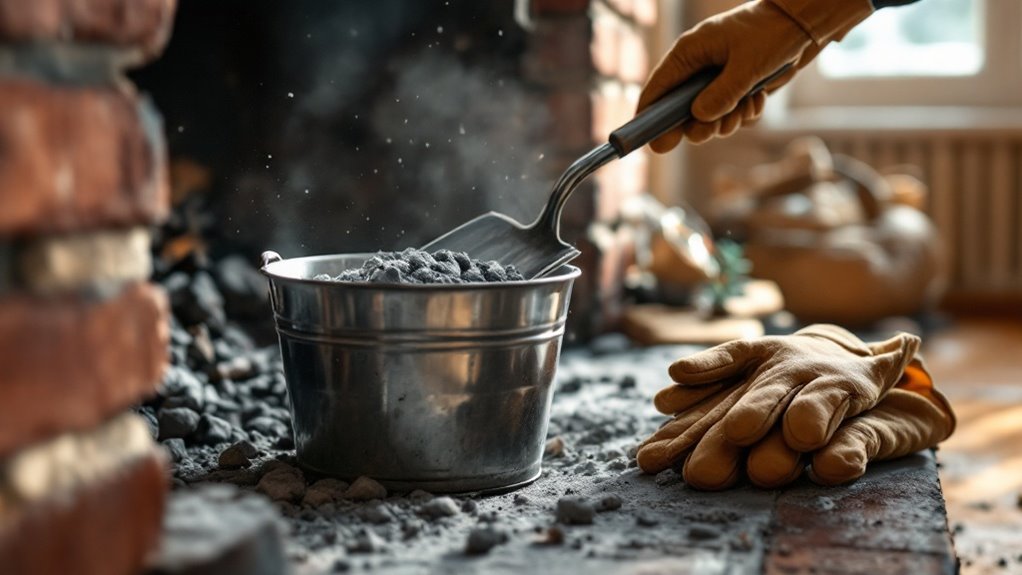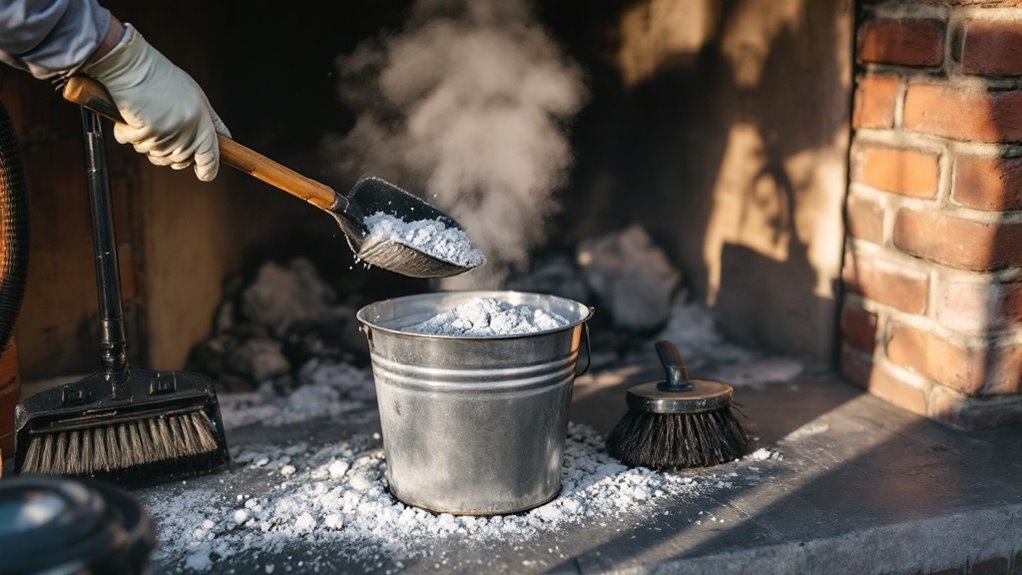You’ll need to start by getting proper permits and hiring certified professionals to inspect for hazardous materials like asbestos. Once cleared, protect the area with sheets and carefully demolish the fireplace starting with the mantel and working down to the firebox. Rent a concrete dumpster for proper disposal of masonry materials. While DIY is possible, structural concerns and safety requirements make this a complex project that requires careful planning and expertise.
Key Takeaways
- Rent a concrete dumpster container specifically designed for heavy masonry materials from a local waste management company.
- Separate demolition materials by type (brick, metal, wood) according to local waste management guidelines for proper sorting.
- Contact your local waste management facility to schedule special pickup or arrange proper disposal methods.
- Remove fireplace materials in manageable sections, placing them directly into the designated disposal container to avoid multiple handling.
- For materials containing asbestos, hire a certified asbestos removal company to ensure safe and legal disposal.
Safety Considerations and Initial Assessment

Before beginning any fireplace removal project, you should rent a concrete dumpster container to safely dispose of heavy masonry materials.
Required Permits and Local Regulations
With safety protocols established, you’ll need to address the legal requirements for fireplace removal. Contact your local building department to learn about specific permits and regulations in your area. Many municipalities require a demolition permit before removing a fireplace, especially if it’s load-bearing or involves structural changes.
You’ll want to check if your homeowner’s association has additional requirements or restrictions. Some areas also require inspections before and after removal, particularly if you’re modifying the chimney. Don’t forget to verify whether you need a certified contractor for the job – many jurisdictions mandate professional removal for safety and compliance reasons. Remember that obtaining proper permits safeguards you from potential fines and validates your home insurance remains valid throughout the removal process.
Professional Inspection and Asbestos Testing
Hiring a certified inspector marks a pivotal first step in fireplace removal. You’ll need to guarantee your fireplace and chimney are free from hazardous materials, particularly asbestos, which was commonly used in older fireplaces. A professional inspection helps you understand the structural implications and identifies potential risks before demolition begins.
Schedule an asbestos test with a certified laboratory, which typically costs between $200-500 and takes 3-5 business days.
Request a thorough chimney inspection to check for liner damage, structural issues, and hidden problems that could affect removal.
Document all inspection findings and keep test results for your records, as you may need them for permits and disposal requirements.
Step-by-Step Removal Process
Once you’ve confirmed the safety of your fireplace through professional testing, it’s time to tackle the systematic removal process. Start by clearing the surrounding area and laying down protective sheets. Remove the mantel, hearth, and any decorative elements first.
Next, carefully demolish the firebox using a sledgehammer and chisel, working from top to bottom. If you’re dealing with a brick fireplace, remove the bricks one by one, starting from the upper corners. Don’t forget to disconnect any gas lines if present.
For the chimney, work in small sections, removing materials from the top down. As you remove debris, sort it into appropriate disposal containers. Remember to wear proper safety gear throughout the process, including a dust mask, safety goggles, and heavy-duty gloves.
Waste Disposal and Site Restoration

Proper disposal of demolition materials kicks off the final phase of your fireplace removal project. You’ll need to separate materials according to your local waste management guidelines, as many areas require specific handling of masonry, metal, and wood components.
Contact your local waste management facility to schedule a special pickup or reserve a dumpster for construction debris. They’ll guide you through sorting requirements and disposal fees.
Restore your floor by patching any gaps with matching materials. If you’ve removed a hearth, you may need to level the subfloor before installing new flooring.
Repair and repaint the surrounding walls and ceiling. Don’t forget to patch any holes from removed support structures or venting systems.
Once completed, you’ll have a clean, restored space ready for your next home improvement project.
Frequently Asked Questions
Can I Reuse Any Parts of My Old Fireplace in a New One?
You can reuse hearth stones, mantels, surrounds, and metal dampers in your new fireplace if they’re in good condition. Check local codes and have a professional inspect salvageable parts first.
How Long Does a Complete Fireplace Removal Typically Take?
You’ll typically need 1-2 days for complete fireplace removal. If you’ve got a standard setup, professional contractors can finish the job in 8-12 working hours with proper equipment.
Will Removing the Fireplace Affect My Home’s Resale Value?
You’ll find that removing a fireplace can impact your home’s value both ways. While some buyers love fireplaces, others prefer the extra space and modern look of rooms without them.
What Can I Do With the Empty Space After Fireplace Removal?
You can transform the space into a stylish entertainment center, cozy reading nook, built-in shelving, or accent wall. Many homeowners also create extra storage or display their favorite artwork there.
Are There Seasonal Considerations for When to Remove a Fireplace?
You’ll want to schedule your fireplace removal during spring or fall when temperatures are mild. Summer heat can make the work uncomfortable, while winter’s cold could affect masonry materials.
Conclusion
You’ve learned the key steps to safely removing your fireplace, from getting proper permits to final cleanup. Remember to prioritize safety throughout the process, work with certified professionals when needed, and follow local disposal regulations. Whether you’re doing a DIY removal or hiring experts, proper planning and careful execution will guarantee a successful fireplace disposal project that meets all requirements.